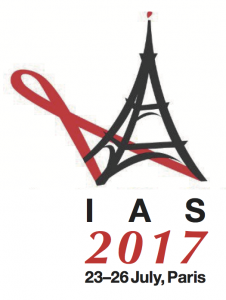Once-daily raltegravir: 96-week results from the ONCEMRK study
1 October 2017. Related: Conference reports, Antiretrovirals, IAS 9th Paris 2017.
Simon Collins, HIV i-Base
Longer follow-up results from the phase 3 registrational ONCEMRK study were presented at IAS 2017 as a later breaking poster. [1]
This was a double-blind, placebo-controlled non-inferiority study in 797 treatment naive participants randomised (2:1) to either the once-daily formulation (2 x 600 mg once-daily) or the original version (400 mg twice-daily). TDF/FTC were used as background NRTIs in both groups.
Baseline characteristics and demographics have been described before but this was a largely was male (85%), white (60%) study with mean (SD) age 36 (+/–10.5) years. Mean CD4 and viral load were 415 cells/mm3 and 4.6 log copies/mL respectively, with 28% having viral load >100,000 copies/mL.
At 96 weeks, viral load was <40 copies/mL in 81% vs 80% of participants (difference: +1.4; 95%CI: –4.4 to +7.3), continuing to show non-inferiority. This compared to the primary endpoint virological response rates of 88% in each arm at week 48 (difference: +0·5%; 95% CI: −4·2 to 5·2).
Response rates at 96 weeks for those with baseline viral load >100,000 copies/mL, were 85% vs 83% (difference: +1.8; 95%CI: –8.2 to +13.6).
Although discontinuation rates were similar in each group (n=64 vs 39) most were due to participant withdrawal or lost to follow-up. Viral non-response was reported in 6 vs 3 participants and discontinuation due to side effects in 7 vs 6 participants.
Resistance to raltegravir was infrequent, occurring in 4/531 (0.8%) and 2/266 (0.8%) in the QD and BID groups, respectively. CD4 responses at week 96 were similar (approximately +260 cells/mm3 in each arm) as were tolerability and side-effects.
comment
Based on 48-week results from ONCEMRK, the once-daily formulation of raltegravir was approved in May 2017. [2]
Raltegravir 600 mg was launched in the UK on 26 September 2017. [3]
The 48-week results from ONCEMRK were also recently published online. [4]
Reference
- Cahn P et al. Raltegravir (RAL) 1200 mg once daily (QD) versus RAL 400 mg twice daily (BID), in combination with tenofovir disoproxil fumarate/emtricitabine (TDF/FTC), in previously untreated HIV-1 infection through week 96. IAS 2017. TULBPEB20.
http://programme.ias2017.org/Abstract/Abstract/5493 (abstract)
http://programme.ias2017.org//PAGMaterial/eposters/5493.pdf (poster PDF) - Merck press statement. Merck receives FDA approval of Isentress HD (raltegravir), a new once-daily option, in combination with other antiretroviral agents, for the treatment of HIV-1 infection in appropriate patients. (30 May 2017).
http://investors.merck.com/news/press-release-details/2017/Merck-Receives-FDA-Approval-of-ISENTRESS-HD-raltegravir-a-New-Once-Daily-Option-in-Combination-with-Other-Antiretroviral-Agents-for-the-Treatment-of-HIV-1-Infection-in-Appropriate-Patients/default.aspx - MSD press release. MSD’s Isentress (raltegravir) 600 mg launched in the UK. (26 September 2017).
http://www.pharmatimes.com/news/msd_launches_once-daily_isentress_in_the_uk_1206406 - Cahn P et al. Raltegravir 1200 mg once daily versus raltegravir 400 mg twice daily, with tenofovir disoproxil fumarate and emtricitabine, for previously untreated HIV-1 infection: a randomised, double-blind, parallel-group, phase 3, non-inferiority trial. Lancet HIV. Published online 11 September 2017. DOI: 10.1016/S2352-3018(17)30128-5.
http://www.thelancet.com/journals/lanhiv/article/PIIS2352-3018(17)30128-5/fulltext

